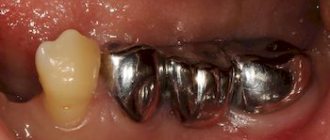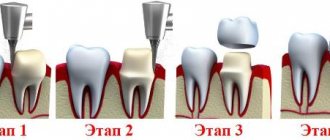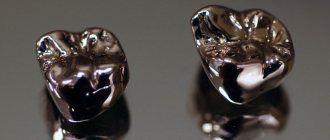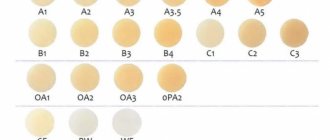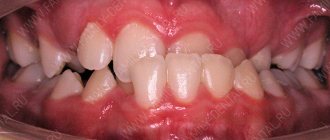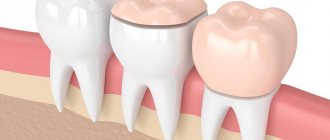From this article you will learn:
- which crowns are best for teeth,
- service life of crowns, guarantee for crowns,
- Which is better – a crown or an implant or a filling.
The choice of dental crowns for dental prosthetics usually occurs between metal-ceramics and metal-free ceramics. However, if the patient makes a choice in favor of metal-ceramics, the dentist immediately offers to choose its options. This can be either standard metal ceramics or highly aesthetic metal ceramics with the so-called “shoulder mass”.
The situation is similar with metal-free ceramics. Ceramic crowns can be made from different types of ceramic, such as zirconia or Emax glass ceramic. Which crowns are best to put on teeth will depend on many factors, for example, whether it is a front or chewing tooth, whether only single crowns or a bridge are needed, as well as on how high the patient’s aesthetic requirements are, and the size of your budget.
Prosthetics of chewing teeth: before and after photos
Clinical cases 1 and 2 –
The choice of the optimal type of crown for the front and posterior teeth will be different. Therefore, if you are more interested in prosthetics of the front teeth, read more about this in the article at the link below.
→ Which crowns are best for the front teeth?
What is a metal crown?
A crown is a microprosthesis that covers the entire surface or a separate part of a destroyed tooth in order to restore its anatomical integrity.
Externally, the manufactured structure resembles a cap used when the tooth structure is destroyed by more than 50%, and a conventional filling is not able to correct this situation. If the segment is completely destroyed, the prosthesis is fixed using adjacent teeth or special implants are used.
Crown installation is a restoration method in which a pre-prepared prosthesis is placed on the remaining tooth (like a cap). Today, in addition to functionality, prosthetics can also solve any aesthetic problems, because modern designs are identical in appearance to natural teeth.
Video on the topic:
How to care for crowns -
If you have single crowns on your teeth, regular floss, brush, and toothpaste after each meal will usually be sufficient. However, when it comes to bridges, hygiene difficulties may arise. After all, the latter have an intermediate part (which restores the lost tooth), and it is under it that food debris accumulates, which is difficult to remove.
Therefore, for patients with bridges, as well as with periodontal pockets in the crown area, we recommend using special irrigators (Fig. 10), which allow you to clean hard-to-reach areas of the oral cavity from food debris and accumulation of soft plaque. These devices create a pulsating stream of high-pressure water, which is supplied through a special nozzle.
Indications for installation
Prosthetics are prescribed by the attending physician in cases where:
- you need to straighten a crooked tooth or change its size/shape/shade;
- fluorosis was detected;
- the inflammatory process damaged more than half of the coronal part of the tooth, and the pulp was removed;
- there is a need to restore a damaged or lost tooth;
- Due to the incorrect location and size of the teeth, dental anomalies are observed. Contraindications include:
- advanced stages of periodontal disease;
- allergic intolerance to the material used;
- malocclusion;
- thinned tooth walls;
- low location of the coronal part of the segment.
Types of dental crowns
In orthopedic practice, well-known metal crowns are still popular. Despite the fact that a wide variety of innovative methods of prosthetics have appeared, metal structures do not lose their positions due to their affordable price and impressive service life.
Sputtered gold crowns were the very first to appear, after which durable steel prostheses began to be actively used.
Depending on the manufacturing method , metal crowns are divided into three groups:
- Stamped. Standard products that require pre-processing with a special machine to give the desired shape. Installation is possible only if at least a third of the tooth crown remains intact.
- Solid cast. Crowns that are created based on the patient’s individual impression. The precision casting method is used, as a result of which it is possible to reproduce the desired anatomical shape of the tooth.
- Combined. These can be either cast or stamped products, the surface of which is lined with plastic or porcelain.
Stamped
Solid cast
Combined
Metal-ceramic crowns: can they be called the best for prosthetics of chewing teeth?
In some materials on the Internet you can see that metal ceramics are advertised as the best material for crowns of chewing teeth. Is it really? Let's try to figure this issue out together, but first we will briefly tell you what metal-ceramic crowns are.
A metal-ceramic crown has a metal base, which is covered with layers of ceramic mass on top. The metal frame ensures the strength of the crown, the ceramic coating provides aesthetics, and some doctors seriously recommend them to their patients as the best option for installation on chewing teeth. In fact, this is not the case; metal-ceramic crowns cannot be called the best for restoring chewing teeth for a number of reasons.
What materials are they made from?
Most people, especially older people, are accustomed to associating the word “crown” with a gold tooth, but modern medicine has advanced so much that the prosthetic products used are practically no different from real teeth.
Reference! The main difference between such designs is the material, the type of which will determine the service life and external aesthetics of the manufactured crown.
Metal
Despite the fact that metal crowns are still used, in the modern world such structures should long ago become a relic of bygone days. Even such significant advantages as high wear resistance and incredible strength do not cover their one, but impressive drawback - an extremely unaesthetic appearance.
In addition, it is quite difficult to place a metal crown on a damaged tooth segment. And finding a clinic that uses such outdated restoration methods is not so easy.
There are two main types of metal crowns:
- from alloys of precious metals : prostheses made from the most popular precious metal - gold. There are also silver structures, but in terms of their characteristics they are significantly inferior to gold prostheses, so at present they are almost never installed;
- from alloys of base metals : crowns made of titanium, which do not have a long service life, but at the same time boast an affordable price.
Gold crowns
Titanium crowns
Metal ceramics
A distinctive feature of such designs is the use of a ceramic coating, which in its appearance resembles real enamel. Metal-ceramic crowns are durable, and their cost is relatively low, so among all the proposed options, these prostheses are the most optimal in terms of price and quality ratio.
There is also a significant drawback: the lack of translucency of the coating when fixed to the front teeth reveals the artificiality of the design. After installation, a gap remains between the gum and the crown, in which the metal base of the product is visible. Because of this, an unaesthetic dark stripe is formed.
There are two varieties :
- on alloys of precious metals : made on the basis of the metal we have already discussed - gold. They differ from ordinary metal products in a more advantageous appearance, but at the same time they are just as wear-resistant and hypoallergenic;
- on alloys of non-precious metals : an alternative to expensive gold products are models made from an alloy of nickel, cobalt and chromium. This material is highly durable, however, over time, the gums under the prosthesis become very dark, and some people may even develop allergic intolerance.
Gold-based metal ceramics
Combined
Metal-plastic
A special plastic overlay is attached to the metal base of the prosthesis, which imitates the structure of tooth enamel.
Such crowns quickly lose their original appearance, change shade and do not have high strength. However, the affordable price and the possibility of rapid production make it possible to use such products as temporary prosthetics.
Which clasp dentures are better for teeth?
Frankly, it is impossible to compare designs with each other and determine which clasp dentures are better for teeth. For the most part, patients consider this type of prosthetics as temporary before implantation. They are left as permanent ones by those who cannot afford alternative methods.
Each type of clasp dentures has its own advantages, indications and contraindications and is recommended in strictly defined cases after studying the clinical picture. The main thing that patients need to know is that even the best orthopedic structures can cause harm if they are improperly manufactured or installed. Turning to inexperienced and incompetent dentists can result in the following troubles:
- breakdown of supporting units (most often within several months after installation of the prosthesis);
- a pathological bite is formed;
- possible deformation of the temporomandibular joint;
- the speed and intensity of tooth abrasion increases;
- complex diction disorders appear that do not go away over time.
An experienced orthopedic dentist can tell you which clasp dentures are best for your teeth.
Manufacturing of solid crowns
The latest technological developments in the field of prosthetic dentistry have allowed us to reach a higher level thanks to the development of cast metal prostheses. Unlike stamped crowns, solid-cast products fit as closely as possible to the teeth, thereby achieving the exact anatomical shape of the destroyed segment.
The production of a cast structure occurs in several stages :
- The dentist conducts a preliminary examination of the oral cavity, studies the patient’s medical record, after which preparation and further taking of all necessary impressions are performed to recreate the anatomical structure of the tooth.
- Next, based on the impressions obtained, specialists make a plaster test model of the crown and model the future product using special wax.
- At the next clinical stage, the patient’s tooth surface undergoes additional grinding. This procedure is necessary to ensure that the created prosthesis fits most tightly to the surface of the tooth. A wax-filled crown is placed on the damaged segment, after which all excess wax is removed through a pre-drilled channel. The orthopedist eliminates all inaccuracies, and the finished sample is sent back to the laboratory for further production of a solid metal structure.
Find out more about the production of solid crowns:
Stamped
Since a stamped crown is a budget type of prosthetics, and the technologies used are not highly accurate, the resulting impression will not be identical to the shape of a natural tooth.
A stamped prosthesis is created as follows :
- To make a model, as in the production of a cast prosthesis, at the initial stage the tooth surface is prepared to give it the desired shape.
- Then impressions are made of two jaws: the one where the crown will be installed, and the opposite one with antagonist teeth. Based on two casts, a plaster model is made, which is later installed in a special occluder.
- At the next stage, wax modeling of the crown is performed, after which they begin to make a plaster stamp. Based on the created plaster model, the subsequent creation of a metal stamp will be carried out.
- At the end of the process, a suitable blank sleeve is selected and the final stamping of the product is done.
How stamped crowns are made:
Types of clasp dentures
Modern orthopedic designs are presented in a variety of options, which differ:
- by type of manufacture;
- by type of fixation.
To understand which clasp dentures are better for teeth and how the models differ from each other, it is necessary to consider each type in more detail.
By type of manufacture
The durability of the orthopedic structure depends on the manufacturing features. Based on this feature, there are several types:
- solid cast;
- soldered;
- milled;
- made by sintering a metal alloy with a special powder.
The most popular and in demand are solid clasp dentures, which are made in one of two ways:
- Based on the impressions taken from the patient, a wax structure is made and then casting is carried out. The resulting plaster model is freed from wax and covered with one of the refractory masses, due to which the wax melts and metal takes its place.
- The prosthesis is cast from fire-resistant material. The frame of the arch is formed from wax. This is the most common method, since metal shrinkage does not occur after, but already at the manufacturing stage. This means that after wax filling and subsequent packaging in a fire-resistant mass, the prosthesis will not lose its original shape.
If you have a choice, then it is better to choose the second method. Such clasp dentures are light in weight and match the gum casts as closely as possible. This guarantees quick and painless adaptation to the structure after its installation.
By type of fixation
The optimally suitable design is selected based on the location of the existing teeth, the presence and size of the spaces between them and taking into account the anatomical shape of the units. According to the method of fastening, clasp dentures are divided into 5 types:
- On clasps
. It is considered the simplest, but allows you to fully restore chewing function. Clasps are hooks with the help of which they are fixed to their own supporting teeth, clasping them. This prosthetic technique does not require the use of crowns, grinding or depulpation of teeth. At the same time, the finished result does not look aesthetically pleasing, since the clasp hooks can be visible when you smile. - Telescopic
. Such clasp dentures are orthodontic devices that require preliminary installation of a non-removable metal telescopic crown on the supporting units. The clasp design has a hollow crown larger in size than the one already on the tooth. During installation, one is put on top of the other, ensuring secure fixation. All types of telescopic models are difficult to manufacture and have a number of contraindications. - On locks (attachments)
. It is a type of telescopic device, but involves the use of locks (attachments). It consists of two parts - one is attached to the turned units, and the second is attached to the prosthesis itself. When fixed, a snap occurs, which guarantees strong adhesion of the parts of the structure, ensuring the most uniform chewing load. The locks are located on the inside, so they are not noticeable when smiling. - Splinting
. Allows you to effectively solve two problems - prosthetics and strengthening of the dentition in order to prevent its further loosening. The main difference from analogues is that on the inside there is an additional arc or claw-shaped metal processes that fix the movable units. - Quadrotti prosthesis
. All parts of such a clasp prosthesis are made of translucent plastic. The result is a plastic but durable structure that bends rather than breaks under dynamic loads. This is an ideal solution for those patients who have contraindications to other types of prosthetics or are diagnosed with an allergy to metal. These devices are also indicated for people who have an increased risk of injury, for example, athletes, firefighters, rescuers, etc.
Unlike other removable structures, which are fixed by suction to the gum or glue, fastening clasp dentures is better, since it allows you to avoid spontaneous falling out of the artificial apparatus from the mouth.
Preparing a tooth for a crown
The successful outcome of a dentist’s work largely depends on preliminary preparation for prosthetics.
If necessary, depulpation is carried out and the root canals are filled. If the carious process has led to further tissue destruction, a mandatory stage of prosthetics is performed - preparation. To do this, hard layers of dental tissue are removed and the segment is ground to the desired shape. Preparation is performed using several methods:
- Ultrasonic turning. The doctor uses special ultrasonic tips with replaceable attachments. This method perfectly levels the tooth surface without leaving any cracks or chips.
- Laser preparation. This type of turning is based on the use of an erbium crystal, which processes tissue using laser irradiation.
- Tunnel grinding method. It is based on the use of turbine units, which, in turn, contributes to excessive heating of tooth enamel. A fairly radical method of treatment, in which it is difficult to avoid painful damage to the gums.
- Air abrasive method. Grinding of the tooth surface occurs due to the impact of an air flow mixed with special powders.
- Chemical preparation. A swab soaked in lactic acid is applied to the desired segment, after which the treated tissue is easily ground down using dental instruments.
Taking an impression to make a crown:
Crowns for teeth: reviews
Unfortunately, it should be noted that patient reviews of dental crowns are more often negative than positive. And this is not due to the fact that artificial crowns themselves are bad, but due to the low quality of their dental manufacturing. The quality of crown manufacturing is influenced by many factors. And this is not only the quality of materials and equipment, but, above all, the professionalism and experience of orthopedists and therapists, as well as dental technicians.
The tooth was poorly prepared for a crown, the root canals were treated poorly - the crown and tooth needed to be redone. The impression of the teeth was poorly taken, cheap materials were used to make the crown - the crown needs to be redone again, and the tooth under the crown may begin to rot. You can read more about the stages of making crowns and what you need to pay special attention to here . We hope that our article: What are the best dental crowns reviews - was useful to you!
Sources:
1. Personal experience as a dentist, 2. “Orthopedic dentistry. Textbook" (Trezubov V.N.), 3. National Library of Medicine (USA), 4. https://www.realself.com/, 5. "Crowns and bridges in orthopedic dentistry" (Smith B.).
Fitting and installation
Installation of a denture occurs in three stages :
- Fitting. Before final fixation, the doctor must try on the manufactured product. In order for the frame of the metal structure to fit tightly to the stump, any flaws and inaccuracies must be excluded. If mistakes are made and the shape is incorrectly made, the prosthesis is sent for additional processing.
- Installation on temporary cement. If the model is made correctly, the specialist proceeds with the subsequent fixation of the crown. First, temporary cement is used to assess the state of the bite and the reaction of the teeth. If any defects are found, the product can be easily removed without any harm to the tooth.
- Installation on permanent cement. If the patient does not experience any discomfort while wearing a crown with temporary cement, the product is removed and fixed with permanent cement.
Advantages and disadvantages of various types of prosthetics
| Product type | Advantages | Flaws |
| Metal ceramics | Affordable price. Not a bad look. Long service life. | Requires significant grinding of the tooth surface. Undesirable placement on the front teeth due to the presence of a translucent metal base. |
| Metal-plastic | Low price. Fast production. | Outdated manufacturing method. Service life is no more than two years. Under the influence of wine and coffee, the material changes its color. |
| Metal | High wear resistance and durability. The optimum ratio of price and quality. | Due to their unaesthetic appearance, they are not suitable for fixation on the front teeth. Can cause an allergic reaction. |
Watch a video about choosing the type of dental crowns:
